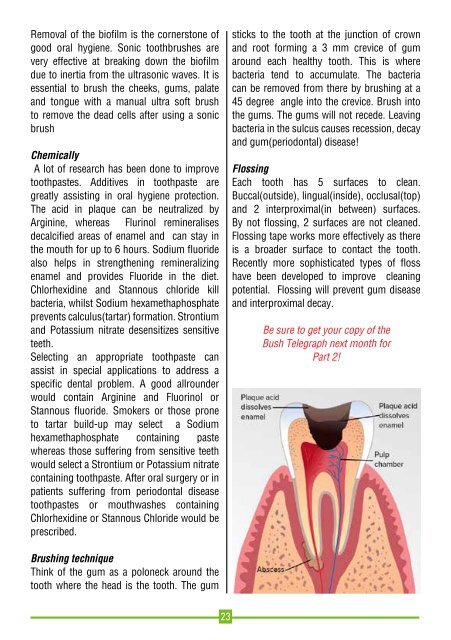BUSH TELEGRAPH
Create successful ePaper yourself
Turn your PDF publications into a flip-book with our unique Google optimized e-Paper software.
Removal of the biofilm is the cornerstone of<br />
good oral hygiene. Sonic toothbrushes are<br />
very effective at breaking down the biofilm<br />
due to inertia from the ultrasonic waves. It is<br />
essential to brush the cheeks, gums, palate<br />
and tongue with a manual ultra soft brush<br />
to remove the dead cells after using a sonic<br />
brush<br />
Chemically<br />
A lot of research has been done to improve<br />
toothpastes. Additives in toothpaste are<br />
greatly assisting in oral hygiene protection.<br />
The acid in plaque can be neutralized by<br />
Arginine, whereas Flurinol remineralises<br />
decalcified areas of enamel and can stay in<br />
the mouth for up to 6 hours. Sodium fluoride<br />
also helps in strengthening remineralizing<br />
enamel and provides Fluoride in the diet.<br />
Chlorhexidine and Stannous chloride kill<br />
bacteria, whilst Sodium hexamethaphosphate<br />
prevents calculus(tartar) formation. Strontium<br />
and Potassium nitrate desensitizes sensitive<br />
teeth.<br />
Selecting an appropriate toothpaste can<br />
assist in special applications to address a<br />
specific dental problem. A good allrounder<br />
would contain Arginine and Fluorinol or<br />
Stannous fluoride. Smokers or those prone<br />
to tartar build-up may select a Sodium<br />
hexamethaphosphate containing paste<br />
whereas those suffering from sensitive teeth<br />
would select a Strontium or Potassium nitrate<br />
containing toothpaste. After oral surgery or in<br />
patients suffering from periodontal disease<br />
toothpastes or mouthwashes containing<br />
Chlorhexidine or Stannous Chloride would be<br />
prescribed.<br />
sticks to the tooth at the junction of crown<br />
and root forming a 3 mm crevice of gum<br />
around each healthy tooth. This is where<br />
bacteria tend to accumulate. The bacteria<br />
can be removed from there by brushing at a<br />
45 degree angle into the crevice. Brush into<br />
the gums. The gums will not recede. Leaving<br />
bacteria in the sulcus causes recession, decay<br />
and gum(periodontal) disease!<br />
Flossing<br />
Each tooth has 5 surfaces to clean.<br />
Buccal(outside), lingual(inside), occlusal(top)<br />
and 2 interproximal(in between) surfaces.<br />
By not flossing, 2 surfaces are not cleaned.<br />
Flossing tape works more effectively as there<br />
is a broader surface to contact the tooth.<br />
Recently more sophisticated types of floss<br />
have been developed to improve cleaning<br />
potential. Flossing will prevent gum disease<br />
and interproximal decay.<br />
Be sure to get your copy of the<br />
Bush Telegraph next month for<br />
Part 2!<br />
Brushing technique<br />
Think of the gum as a poloneck around the<br />
tooth where the head is the tooth. The gum<br />
23




